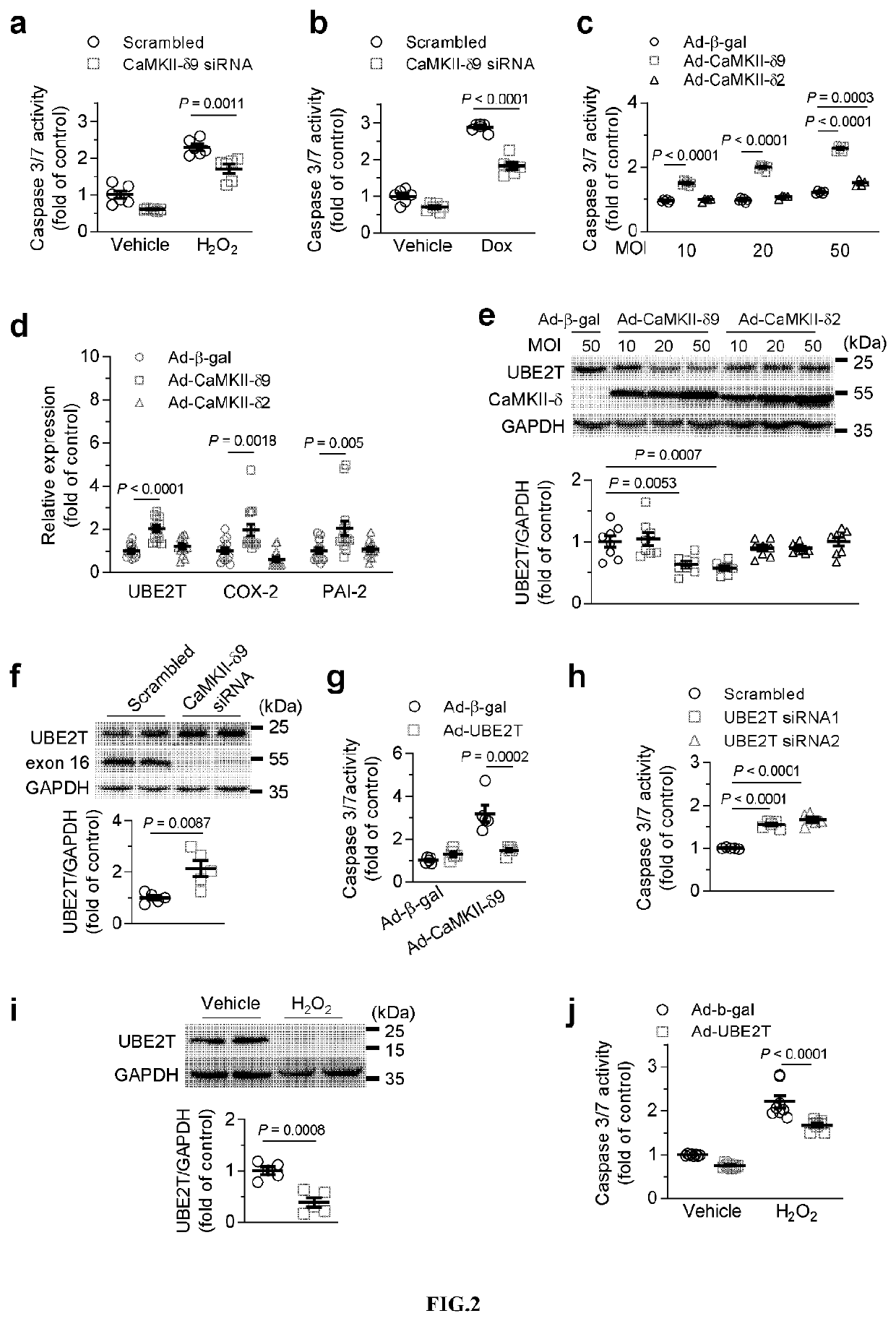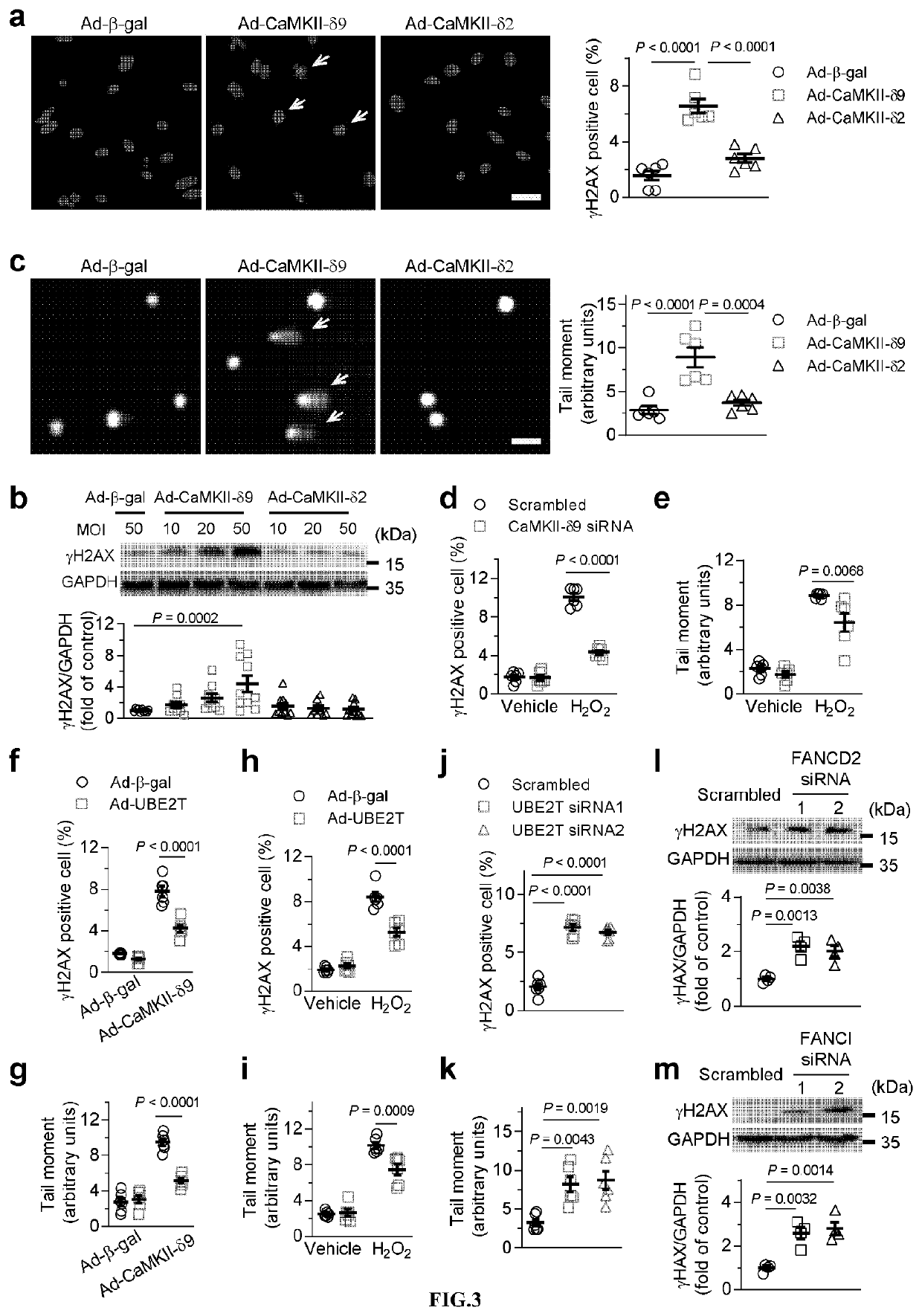Antagonists of camkii-delta 9 and uses thereof
a technology of camkii and delta 9 is applied in the field of biomedical drugs, which can solve the problems of dna damage, cell death, and the largely unknown mechanism of cardiomyocyte dna repair
- Summary
- Abstract
- Description
- Claims
- Application Information
AI Technical Summary
Benefits of technology
Problems solved by technology
Method used
Image
Examples
embodiments
[0185]The biological materials used in all examples, various clones and expression plasmids, media, enzymes, buffer solutions, and various culturing methods, protein extraction and purification methods, and the other molecular biological operation methods, are all well-known to those of skill in the art. For more details, please refer to the “Molecular Cloning: A Laboratory Manual” edited by Sambrook, et al. (Cold Spring Harbor, 1989) and “Short Protocols in Molecular Biology” (Frederick M. Ausubel, et al., translated by Yan Ziying et al., Science Press (Beijing), 1998).
[0186]General Methods and Materials
[0187]1.1 Animals
[0188]Animals were maintained in the Center for Experimental Animals (an Association for Assessment and Accreditation of Laboratory Animal Care-accredited experimental animal facility) at Peking University, Beijing, China. The animals were randomly allocated to experimental groups. Only males were used. No non-inclusion or exclusion parameters were used in our studi...
example 1
nce of CaMKII-δ9 in Human Heart
[0251]The inventors performed single-molecular real-time (SMRT) sequencing (Pacific Biosciences) (Sharon, D. et al., Nature biotechnology 31, 1009-1014, doi:10.1038 / nbt.2705 (2013)) of cardiac tissue from mouse, rat, rhesus monkey, and human to detect the concentrations of splice variants of CaMKII-δ. The library preparation, sequencing, and data collection for SMRT sequencing were described in Section 1.3 of GENERAL METHODS AND MATERIALS. The quantification of CaMKII-δ splice variants was performed according to the methods as described in Section 1.7 of GENERAL METHODS AND MATERIALS.
[0252]Surprisingly, the inventors found that the well-studied splice variant CaMKII-δ2 was extremely low in the hearts of rhesus monkey (3.1%) and human (6.3%), although it accounted for 29% and 22.5% of the total cardiac CaMKII-δ transcripts in mouse and rat, respectively. The previously-reported but functionally-overlooked CaMKII-δ9 emerged as a very abundant splice vari...
example 2
ion of CaMKII-δ9 is Associated with Various Cardiac Diseases
[0255]To investigate the pathological relevance of CaMKII-δ9, the inventors first evaluated its levels in several cardiac injury models. To mimic hemodynamic pressure overload, the inventors performed transverse thoracic constriction (TAC) surgery in mice. The experimental methods, animals, and materials used in this Example were described in Sections 1.1, 1.2, 1.4, 1.15, 1.18, 1.19, 1.26 and 1.27 of GENERAL METHODS AND MATERIALS.
[0256]The expression of CaMKII-δ9 was significantly elevated in NRVMs exposed to the chemotherapeutic drug Doxorubicin (Dox; 1 μM), or oxidative stress with H2O2 (200 μM) (FIG. 1e, f). The protein level of CaMKII-δ9 was overtly increased in TAC hearts relative to the sham group (FIG. 1g). More importantly, CaMKII-δ9 was profoundly elevated in cardiac tissue from patients with hypertrophic cardiomyopathy (HCM) relative to controls (FIG. 1h). It is known that CaMKII is activated through both phosphor...
PUM
| Property | Measurement | Unit |
|---|---|---|
| pH | aaaaa | aaaaa |
| flow rate | aaaaa | aaaaa |
| pH | aaaaa | aaaaa |
Abstract
Description
Claims
Application Information
 Login to View More
Login to View More - R&D
- Intellectual Property
- Life Sciences
- Materials
- Tech Scout
- Unparalleled Data Quality
- Higher Quality Content
- 60% Fewer Hallucinations
Browse by: Latest US Patents, China's latest patents, Technical Efficacy Thesaurus, Application Domain, Technology Topic, Popular Technical Reports.
© 2025 PatSnap. All rights reserved.Legal|Privacy policy|Modern Slavery Act Transparency Statement|Sitemap|About US| Contact US: help@patsnap.com



